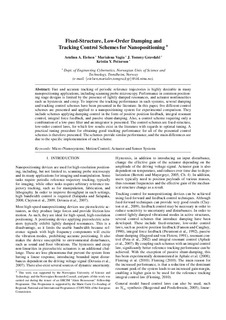| dc.contributor.author | Eielsen, Arnfinn Aas | |
| dc.contributor.author | Vagia, Marialena | |
| dc.contributor.author | Gravdahl, Jan Tommy | |
| dc.contributor.author | Pettersen, Kristin Ytterstad | |
| dc.date.accessioned | 2017-06-08T08:42:55Z | |
| dc.date.available | 2017-06-08T08:42:55Z | |
| dc.date.created | 2014-01-15T09:57:25Z | |
| dc.date.issued | 2013 | |
| dc.identifier.citation | IEEE/ASME transactions on mechatronics. 2013, 19 (2), 432-444. | nb_NO |
| dc.identifier.issn | 1083-4435 | |
| dc.identifier.uri | http://hdl.handle.net/11250/2445391 | |
| dc.description.abstract | Fast and accurate tracking of reference trajectories is highly desirable in many nanopositioning applications, including scanning probe microscopy. Performance in common positioning stage designs is limited by the presence of lightly damped resonances and actuator nonlinearities such as hysteresis and creep. To improve the tracking performance in such systems, several damping and tracking control schemes have been presented in the literature. In this paper, six different control schemes are presented and applied to a nanopositioning system for experimental comparison. They include schemes applying damping control in the form of positive position feedback, integral resonant control, integral force feedback, and passive shunt-damping. Also, general pole placement in the form of model reference control, as well as a control scheme requiring only a combination of a low-pass filter and an integrator, is presented. The control schemes are fixed-structure, low-order control laws, for which few results exist in the literature with regard to optimal tuning. A practical tuning procedure for obtaining good tracking performance for five of the control schemes is, therefore, presented. Experimental results show that the schemes provide similar performance, and the main differences are due to the specific implementation of each scheme. | nb_NO |
| dc.language.iso | eng | nb_NO |
| dc.publisher | IEEE | nb_NO |
| dc.title | Damping and Tracking Control Schemes for Nanopositioning | nb_NO |
| dc.type | Journal article | nb_NO |
| dc.type | Peer reviewed | nb_NO |
| dc.description.version | acceptedVersion | nb_NO |
| dc.source.pagenumber | 432-444 | nb_NO |
| dc.source.volume | 19 | nb_NO |
| dc.source.journal | IEEE/ASME transactions on mechatronics | nb_NO |
| dc.source.issue | 2 | nb_NO |
| dc.identifier.doi | 10.1109/TMECH.2013.2242482 | |
| dc.identifier.cristin | 1090473 | |
| dc.relation.project | Norges forskningsråd: 193265 | nb_NO |
| dc.relation.project | Norges forskningsråd: 192427 | nb_NO |
| dc.description.localcode | © 2013 IEEE. Personal use of this material is permitted. Permission from IEEE must be obtained for all other uses, in any current or future media, including reprinting/republishing this material for advertising or promotional purposes, creating new collective works, for resale or redistribution to servers or lists, or reuse of any copyrighted component of this work in other works. This is the authors' accepted and refereed manuscript to the article. | nb_NO |
| cristin.unitcode | 194,63,25,0 | |
| cristin.unitname | Institutt for teknisk kybernetikk | |
| cristin.ispublished | true | |
| cristin.fulltext | postprint | |
| cristin.qualitycode | 1 | |
